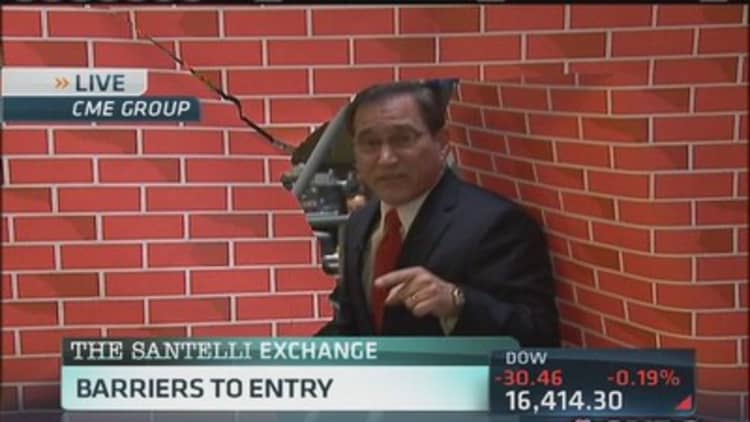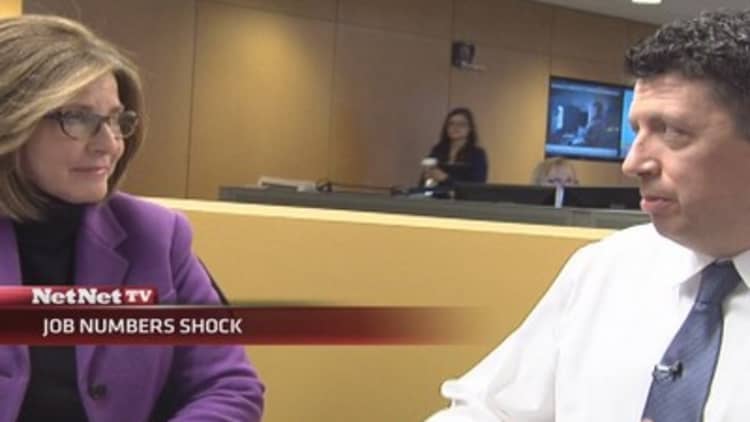The shocking drop in December job creation to the worst level in three years raises questions about Fed policy, but it's unlikely the Fed will change course unless other data show the economy faltering.
There were a paltry 74,000 nonfarm payrolls added in December and the unemployment rate fell to 6.7 percent, largely due to a decline in individuals looking for work. Economists had expected about 200,000 and an unemployment rate of 7 percent—consistent with the last several months.
"I describe this as a weather-related clunker," said John Canally, investment strategist and economist at LPL Financial. "Only 1,000 drop in transportation and warehousing. That was up 35,000 the month before and then a big drop in government jobs so I think the Fed will see through this as a weather issue but of course the weather in January was pretty cold as well so it might be a couple of months before we get a cleaner reading on the report but I think the weather is the key."

The Fed has said it would begin to taper back its $85 billion monthly bond purchases by $10 billion this month because it sees an improving economy. But whether the Fed continues to pare back the program, at the $10 billion pace expected, is up for debate.
Daniel Greenhaus, chief global strategist at BTIG, however, said the Fed may not take further action at its January meeting. "The economy, based on any number of other indicators, has been picking up steam of late which makes today's number ... curious. We aren't sure how the Fed should react to this number but we think another reduction at the January FOMC meeting is probably unlikely. Investors though have already cast their vote; bad news is bad news," he wrote.
Others disagree. "We believe the Federal Reserve will look through the softness in this report, and we continue to expect that the Fed will further reduce the pace of its purchases by $10 billion at the January FOMC meeting," Barclays economists wrote in a note.
(Read more: )

John Briggs, head of cross asset strategy at RBS, said one report will not stop the Fed. "I lean towards them sticking to plan," said Briggs.
"The data series can be volatile. You had 200,000 for October and 241,000 for November with revisions. That puts the three-month average at 170,000 which is disappointing, but I don't think it's enough to change the tapering plan and with the unemployment rate, it makes it difficult to see a major rally in Treasurys," said Briggs.
The Fed has targeted 6.5 percent as a level to consider raising short-term rates, but Fed watchers believe that is not a hard-line target and the Fed will be flexible.
"I think yields could probably go lower because people were short but I'm not sure you get past 2.75 and 2.80 (10-year yield) because of the constraints on the Fed because of where the unemployment rate is," Briggs said.
JPMorgan chief U.S. economist Michael Feroli said the disappointing jobs report makes Fed Chairman Ben Bernanke's final meeting as chairman particularly difficult on Jan. 28 and 29. Fed Vice Chair Janet Yellen takes over as chairman after that meeting.
Feroli, in a note, said the Fed could find enough special factors to justify that the number is distorted and it should proceed with a $10 billion taper at its January meeting.
"The forward guidance decision could be even more difficult than the tapering call. Rather than lower the unemployment threshold further—which would be doubling down on predicating policy on an arguably flawed statistic—we think the Committee will continue along the path of downplaying the significance of the unemployment rate in the setting of interest rate policy," he wrote.
Ironically, the bombshell employment report comes in the same week that many in the markets were talking about whether the Fed would move early to raise rates because of stronger growth.
(Read more: Job growth weak, raising questions about Fed move)
Stocks slumped at midday, after initially rising Friday, and bond yields moved lower. The 10-year was yielding 2.88 percent, below the 2.97 percent yield earlier in the day.
Another negative in the report was a decline in the participation rate, which fell to 62.8 percent, the same as the October rate and the lowest since 1978. It had been at 63 percent in November. From 2003 to 2007, it was closer to 66 percent. The rate reflects the number of Americans working or actively looking for jobs.
There had been high hopes for the December jobs report and expectations that it might confirm new momentum that has been showing up in consumer spending, trade data and industrial production.
But instead it raises real questions about whether the pickup in GDP growth—to 4.1 percent in Q3 and as much as 3 percent in Q4—will now sputter like so many other rebounds have since the recovery began. Barclays economists said Q4 GDP was tracking a tenth higher at 3.4 percent, after further strength in wholesale inventories Friday.
"I don't believe it. I would just ignore it. I think it will be revised away," said Moody's Analytics chief economist Mark Zandi of the jobs report. He said the report reflects what should be a very weak underlying economy, which none of the other data indicate. "This is just one of those out-of-bounds numbers."
As for the Fed, officials will wait for more data before altering their plans, and he expects them to proceed with tapering. "I don't think they'll feel the trend has shifted," he said.

The smaller household survey showed that 273,000 people stayed home because of bad weather, the highest level since 1977. Feroli also noted the number of people who said they couldn't make it to work was about 100,000 more than average for December.
Briggs said his initial read on the weather impact was that it might account for 50,000 to 75,000 jobs.
Many traders had expected a stronger-than-forecast jobs report since other jobs-related data have signaled an improving trend in hiring. ADP released private-sector payroll data Wednesday showing 238,000 private-sector jobs added in December, the best number in a year. November jobs were revised to 229,000, bringing the monthly pace of private-sector hiring to 225,000.
(Read more: Jobless claims tumble, fanning hopes for labor market thaw)
Challenger Gray & Christmas said planned layoffs fell by 32 percent in December to the lowest level since June 2000.
Perhaps the most trusted reading on employment is the more current weekly jobless claims data. Thursday's report showed that the number of new unemployment claims dropped by 15,000 in the week ended Jan. 4, to 330,000. Claims are volatile around the holiday season and were elevated in December but have now dropped back to a slightly lower-than-expected level.
Meanwhile, small-business hiring, a major engine of the job market, appears to be improving. The National Federation of Independent Business said its survey of small-business owners showed companies increased employment in December by an average of 0.24 workers per company, the best reading since February 2006.
—By CNBC's Patti Domm. Follow her on Twitter @pattidomm.


